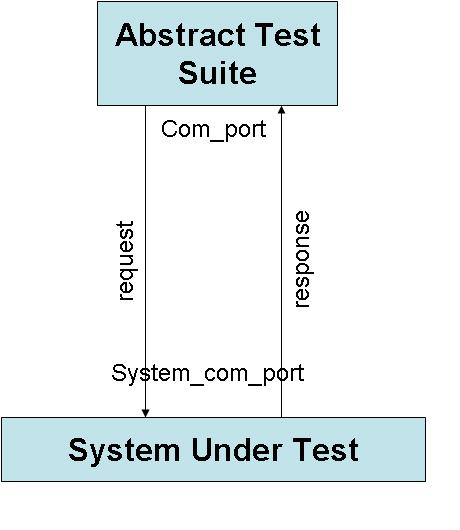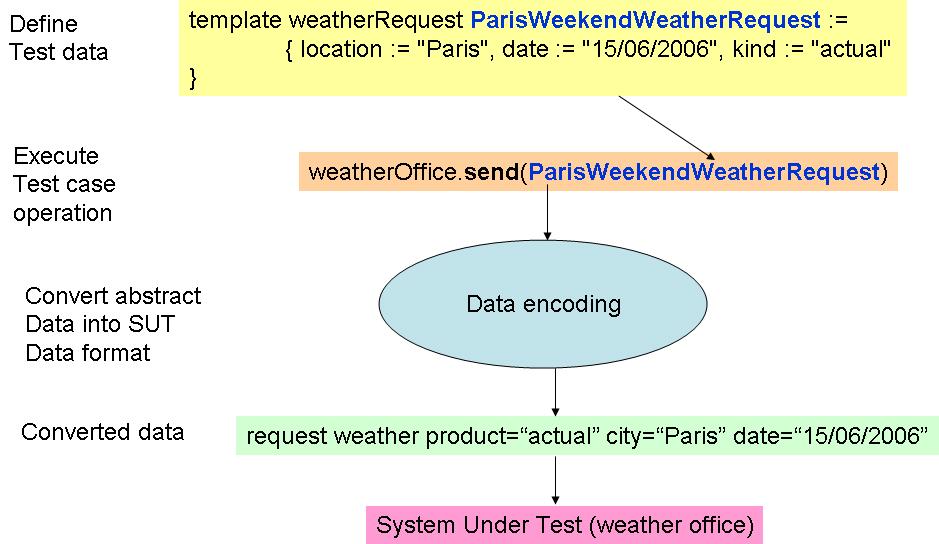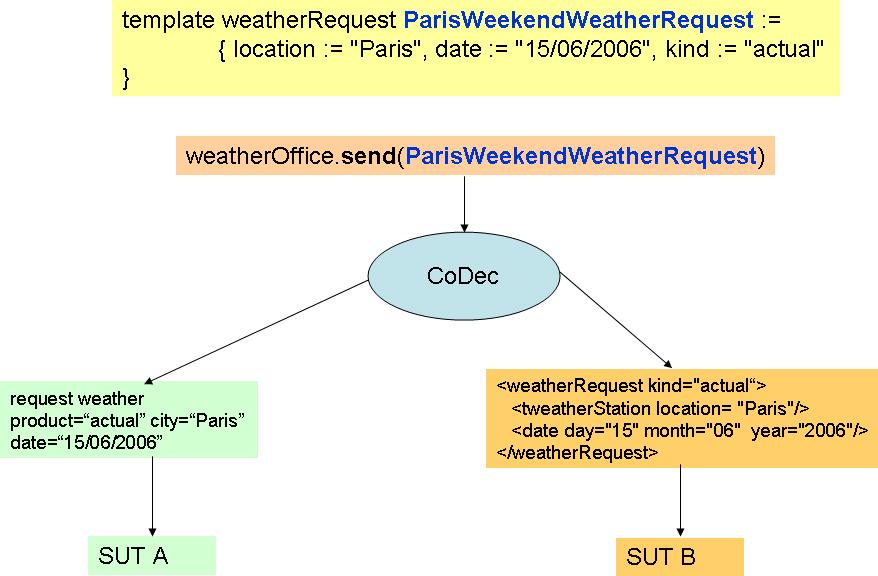TTCN-3 in a Nutshell
by Bernard Stepien
University of Ottawa
What is TTCN-3?
 TTCN-3 is a test scripting language
TTCN-3 is a test scripting language
 TTCN-3 is an international standard
TTCN-3 is an international standard
 TTCN-3's main feature is the separation of concern between Abstract Test Suites
and the Adapter Layer which allows full portability of test suites and thus make them independent
of any platform implementation. The test adapter handles all platform and implementation languages (java, C, C++) issues
for the communication with a System Under Test and also the actual coding and decoding requirements of
an application.
TTCN-3's main feature is the separation of concern between Abstract Test Suites
and the Adapter Layer which allows full portability of test suites and thus make them independent
of any platform implementation. The test adapter handles all platform and implementation languages (java, C, C++) issues
for the communication with a System Under Test and also the actual coding and decoding requirements of
an application.
 TTCN-3 has a powerfull matching mechanism
TTCN-3 has a powerfull matching mechanism
TTCN-3 basic testing model

TTCN-3 Test Adapter concept

A TTCN-3 example
The following is an example of an Abstract Test Suite (ATS) where we are trying to test a weather service.
The tester sends a request consisting
of a location, a date and a kind of report to some on-line weather service and receives a response with
confirmation of the location and date along with the temperature, the wind velocity and the weather conditions at this location.
A TTCN-3 ATS is always composed of four sections:
 type definitions:
data structures like in C but also an easy to use concept of lists and sets.
type definitions:
data structures like in C but also an easy to use concept of lists and sets.
 template definitions:
A TTCN-3 template consists of two separate concepts merged into one:
template definitions:
A TTCN-3 template consists of two separate concepts merged into one:
- test data definition
- test data matching rules
 test cases definitions:
specifies the sequences and alternatives of sequences of messages sent and received to and from the System Under Test (SUT)
test cases definitions:
specifies the sequences and alternatives of sequences of messages sent and received to and from the System Under Test (SUT)
 test control definitions
defines the order of execution of various test cases
test control definitions
defines the order of execution of various test cases
Sample TTCN-3 Abstract Test Suite
module SimpleWeather {
type record weatherRequest {
charstring location,
charstring date,
charstring kind
}
template weatherRequest ParisWeekendWeatherRequest := {
location := "Paris",
date := "15/06/2006",
kind := "actual"
}
type record weatherResponse {
charstring location,
charstring date,
charstring kind,
integer temperature,
integer windVelocity,
charstring conditions
}
template weatherResponse ParisResponse := {
location := "Paris",
date := "15/06/2006",
kind := "actual",
temperature := (15..30),
windVelocity := (0..20),
conditions := "sunny"
}
type port weatherPort message {
in weatherResponse;
out weatherRequest;
}
type component MTCType {
port weatherPort weatherOffice;
}
testcase testWeather() runs on MTCType {
weatherOffice.send(ParisWeekendWeatherRequest);
alt {
[] weatherOffice.receive(ParisResponse) {
setverdict(pass)
}
[] weatherOffice.receive {
setverdict(fail)
}
}
}
control {
execute (testWeather())
}
}
The role of the test adapter and codec
The test adapter and the codec are the glue between the Abstract Test Suite and the System
Under Test. It converts the data into the format that the SUT understands.

In the above example, the abstract data is converted into a text string with
some command "request weather", and pairs of field names and field values.
Note that the concrete field names are intentionally different than the abstract
types field names.
The adapter layer enables us to re-use the same abstract test cases for
different weather forecast providers.
For example while provider A may use the above text messages, provider B may
use an XML representation instead in the following form:
<weatherRequest kind="actual">
<weatherStation location= "Paris"/>
<date day="15" month="06" year="2006"/>
</weatherRequest>
Abstract Test Cases re-usability

What is the TTCN-3 Matching Mechanism?
The TTCN-3 matching mechanism enables to specify the values expected in a response from the SUT
in a user-friendly and concise way. It is composed of two language constructs:
template weatherResponse ParisResponse := {
location := "Paris",
date := "15/06/2006",
kind := "actual",
temperature := (15..30),
windVelocity := (0..20),
conditions := "sunny"
}
a behavior receive statement
weatherOffice.receive(ParisResponse);
setverdict(pass)
The receive statement uses the template definition to specify that the data received
from the SUT should match the values of the fields of this template.
The template enables to specify a variety of matching rules:
- single value: location="Paris"
- list of alternate values: conditions= ("cloudy", "overcast")
- sets of unordered values: (a ,c ,b) or (c,a, b), etc...
- ranges of numeric values: temperature := (12..50)
- string patterns: conditions:= pattern "*snow* " will match the phrase "light snow"
Test Behavior specification
When a SUT can respond in different ways to the same stimuli, we represent
this behavior using trees. Branches of the behavior tree are specified with the
TTCN-3 alt construct.
TTCN-3 achieves yet another separation of concern. It separates behavior from the conditions governing behavior. TTCN-3 enables to specify test behavior as trees of alternate behaviors. The conditions governing this behavior are specified using TTCN-3 templates that in essence act as traditional if-then-else statements but in a very concise way. This behavior presentation approach enables a clear overview quality of the test behavior, a quality rarely found in traditional programming languages.

In our weather service example, we use an alternative to specify the possibility to
receive an unexpected and unspecified response message in which case we could
decide that the test case failed.
Verdicts are usually located in the leafs of the behavior tree.
alt {
[] weatherOffice.receive(ParisResponse) {
setverdict(pass)
}
[] weatherOffice.receive {
setverdict(fail)
}
}
Parametrization
One of TTCN-3's major feature is parametrization. This feature enables to
maximize the principle of re-usability.
 Parametric templates
Parametric templates
templates can be assembled using other templates.
template myTypeA myRomeLocation := {
city := "Roma",
country := "italy"
}
template myTypeB myGenericWeatherRequest (myTypeA theLocationTemplate) := {
location := theLocationTemplate,
request := "road conditions"
}
the above template myGenericWeatherRequest can be actualized when used in a TTCN-3
send or receive operation:
weatherOffice.send(myGenericWeatherRequest(myRomeLocation));
...
 Parametric test cases
Parametric test cases
templates can be passed to a test case or function as parameters and can
be used in any of the TTCN-3 send or receive operation.
testcase testWeather(myTypeB theWeatherRequest, someResponseType theExpectedResponse) runs on MTCType {
weatherOffice.send(theWeatherRequest);
alt {
[] weatherOffice.receive(theExpectedResponse) {
setverdict(pass)
}
[] weatherOffice.receive {
setverdict(fail)
}
}
}
The above test case can be executed with actual values as follows:
execute(testWeather(myGenericWeatherRequest(myRomeLocation), myExectedResponse));
...
and this test case can be re-used for a variety of similare tests like in our case checking
the weather in different locations:
execute(testWeather(myGenericWeatherRequest(myParisLocation), parisExpectedResponse));
...
Where to obtain the TTCN-3 standard
The TTCN-3 standard can be obtained free of charge from ETSI: link to the official TTCN-3
Web Site
more tutorials:
More tutorials and examples about using TTCN-3 for the purpose of testing web applications can be found here
 Contact
Contact

